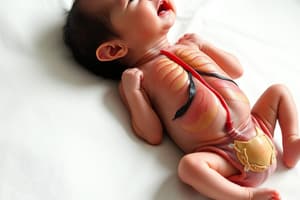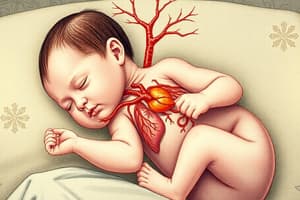Podcast
Questions and Answers
Which physiological change is NOT a primary stimulus for a newborn's first breath?
Which physiological change is NOT a primary stimulus for a newborn's first breath?
- Increased carbon dioxide (CO2) levels
- Decreased pH
- Increased surfactant production (correct)
- Decreased oxygen (O2) levels
A newborn exhibits short pauses in breathing lasting less than 15 seconds with no changes in color or heart rate. How should this be interpreted?
A newborn exhibits short pauses in breathing lasting less than 15 seconds with no changes in color or heart rate. How should this be interpreted?
- A normal finding known as periodic breathing. (correct)
- An indication of respiratory distress requiring immediate intervention.
- A sign of surfactant deficiency.
- Evidence of a congenital heart defect.
What is the primary mechanism by which fetal lung fluid is cleared after birth?
What is the primary mechanism by which fetal lung fluid is cleared after birth?
- Coughing and expectoration
- Excretion through urine
- Evaporation through the skin
- Absorption by the lymphatic system and pulmonary capillaries (correct)
Why is surfactant crucial for newborn respiratory function?
Why is surfactant crucial for newborn respiratory function?
During an assessment, what would be considered a normal respiratory rate for a healthy newborn?
During an assessment, what would be considered a normal respiratory rate for a healthy newborn?
A baby is born via Cesarean section at 38 weeks gestation. Why might this infant have more difficulty clearing lung fluid compared to a vaginally delivered infant?
A baby is born via Cesarean section at 38 weeks gestation. Why might this infant have more difficulty clearing lung fluid compared to a vaginally delivered infant?
A nurse observes a newborn exhibiting nasal flaring and intercostal retractions. What do these signs indicate?
A nurse observes a newborn exhibiting nasal flaring and intercostal retractions. What do these signs indicate?
Knowing newborns are obligate nose breathers, what nursing intervention is most important when a newborn has nasal congestion?
Knowing newborns are obligate nose breathers, what nursing intervention is most important when a newborn has nasal congestion?
A premature infant is at higher risk for respiratory distress syndrome (RDS) due to a deficiency in which substance?
A premature infant is at higher risk for respiratory distress syndrome (RDS) due to a deficiency in which substance?
What is the primary purpose of surfactant in the alveoli of a newborn's lungs?
What is the primary purpose of surfactant in the alveoli of a newborn's lungs?
Flashcards
Extrauterine Transition
Extrauterine Transition
Significant physiological and behavioral changes for newborns adjusting to life outside the womb.
Initiation of Breathing
Initiation of Breathing
Breathing begins due to increased CO2, decreased O2/pH, and external stimuli after birth.
Surfactant
Surfactant
Lipoprotein that reduces surface tension in alveoli, preventing collapse.
Normal Newborn Respiratory Rate
Normal Newborn Respiratory Rate
Signup and view all the flashcards
Periodic Breathing
Periodic Breathing
Signup and view all the flashcards
Study Notes
- The transition from intrauterine to extrauterine life requires significant physiological and behavioral adaptations in the newborn
- This period involves the establishment of respiratory, circulatory, and temperature regulation, along with the ability to feed and eliminate waste
Respiratory System Adaptations
- Initiation of breathing is crucial, with the first breath expanding the collapsed alveoli
- Several factors stimulate the first breath: increased CO2 levels, decreased O2 and pH, and thermal and tactile stimuli
- Lung fluid is cleared via the lymphatic system and pulmonary capillaries, aided by vaginal delivery
- Surfactant, a lipoprotein, reduces surface tension in the alveoli, preventing collapse upon expiration
- Normal respiratory rate for a newborn is 30-60 breaths per minute
- Newborns are primarily nose breathers
- Periodic breathing, characterized by short pauses (<15 seconds) without changes in color or heart rate, is common
- Signs of respiratory distress include nasal flaring, retractions, grunting, seesaw respirations, and tachypnea
Cardiovascular System Adaptations
- The circulatory system undergoes significant changes at birth
- The foramen ovale, ductus arteriosus, and ductus venosus close, transitioning to pulmonary circulation
- Closure of these shunts redirects blood flow through the lungs for oxygenation
- Heart rate ranges from 110-160 beats per minute
- Blood pressure varies depending on gestational age and weight, typically around 60-80/40-50 mm Hg
- Acrocyanosis (bluish discoloration of hands and feet) is normal in the first 24 hours
- Heart murmurs may be present but are often transient and resolve within six months
Thermoregulation
- Newborns are prone to heat loss due to a large surface area to body mass ratio, limited subcutaneous fat, and inability to shiver
- Non-shivering thermogenesis, the primary method of heat production, involves burning brown adipose tissue (BAT)
- Mechanisms of heat loss include evaporation, conduction, convection, and radiation
- Maintaining a neutral thermal environment (NTE) minimizes oxygen and calorie consumption
- Normal axillary temperature ranges from 36.5°C to 37.5°C (97.7°F to 99.5°F)
- Hypothermia can lead to cold stress, increasing oxygen consumption and potentially causing respiratory distress and hypoglycemia
Hepatic System Adaptations
- The liver plays a key role in glucose regulation, bilirubin conjugation, and blood coagulation
- Glucose levels stabilize within the first few hours after birth
- Hypoglycemia (blood glucose <40 mg/dL) requires intervention
- Physiological jaundice, caused by the immature liver's inability to conjugate bilirubin, is common after 24 hours
- Bilirubin is excreted in the stool; early feeding promotes bilirubin excretion
- Breastfed infants may experience breast milk jaundice, related to factors in breast milk affecting bilirubin metabolism
- Vitamin K, administered shortly after birth, is necessary for blood clotting due to the sterile gut's inability to produce it
Gastrointestinal System Adaptations
- The newborn's digestive system is initially sterile
- Bacteria colonization begins shortly after birth
- Meconium, the first stool, is thick, tarry, and greenish-black
- Transitional stools are greenish-brown and looser
- Breastfed infants have seedy, yellow stools
- Formula-fed infants have pale yellow to light brown stools
- Regurgitation is common due to an immature lower esophageal sphincter
- Newborns can digest simple carbohydrates, proteins, and fats, but may have difficulty with complex carbohydrates
Urinary System Adaptations
- Newborns have limited ability to concentrate urine
- The first void should occur within 24 hours
- Frequency of urination increases over the first few days
- Brick dust staining (pinkish stains) on diapers may occur due to urate crystals
Immune System Adaptations
- Newborns have limited immune function
- They primarily rely on passive immunity from maternal antibodies (IgG) transferred during gestation
- Breastfeeding provides additional antibodies (IgA)
- Newborns begin producing their own antibodies, but immune competence is achieved over time
Neurological System Adaptations
- The neurological system is immature but sufficiently developed for survival
- Newborn reflexes, such as sucking, rooting, Moro, and grasping, are present
- These reflexes indicate neurological integrity
- Sensory capabilities include vision (prefers faces and patterns), hearing (responds to sounds), taste (prefers sweet), smell (recognizes mother's scent), and touch (sensitive to pain and temperature)
- The anterior fontanel closes within 12-18 months; the posterior fontanel closes within 2-3 months
Behavioral Adaptations
- The newborn exhibits predictable behavioral patterns
- Sleep-wake states include deep sleep, light sleep, drowsy, quiet alert, active alert, and crying
- The Brazelton Neonatal Behavioral Assessment Scale (NBAS) evaluates the newborn's reflexes, motor abilities, state changes, and social interactive behaviors
- Habituation, the ability to block out repetitive stimuli, is an important adaptive behavior
- Newborns can self-console through sucking on hands or fingers
- Social behaviors, such as cuddling and snuggling, facilitate bonding with caregivers
Studying That Suits You
Use AI to generate personalized quizzes and flashcards to suit your learning preferences.




